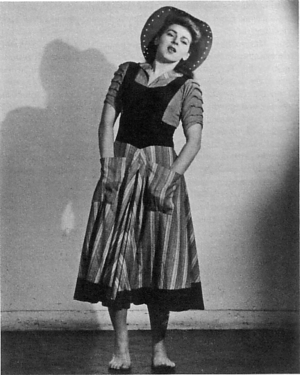Sophie Maslow
The modern dance pioneer Sophie Maslow was born in New York City, the daughter of left-wing secular Jews, and she lived all her life there. She began dancing at a young age, first through a socialist school and then at the Neighborhood Playhouse, a theater that grew out of the Henry Street Settlement, where Martha Graham and Blanche Talmud were among her teachers. Maslow also attended Camp Kinderland and later worked there, along with several other Jewish modern dancers.
Maslow began her career in dance at the time of the Depression and heightened labor activism. During this period, some workers saw dance (particularly modern dance) not as an art form for privileged people but rather as a potentially revolutionary medium that could express and celebrate the experiences of workers. They formed left-leaning dance organizations such as the Workers' Dance League and the New Dance Group. Though Maslow did not see her own work as explicitly political or ideological, she used dance to explore folk traditions (including those of her own Jewish heritage) and the stories of common people.
In 1931, Sophie joined the Martha Graham Company and danced with them for ten years. She also began choreographing her own dance pieces on themes of Soviet culture and social protest for the Workers' Dance League and the New Dance Group, for which she also served as a teacher in their low-cost classes.
One of her most popular works was "Dust Bowl Ballads" (1941), set to Woody Guthrie's songs about rural people during the Depression. Another work considered a masterpiece is "Folksay" (1942), based on Carl Sandburg's poem "The People, Yes."
After World War II, Maslow turned her attention to Russian Jewish folk traditions. In 1950, she choreographed "The Village I knew" from Sholem Aleichem's stories of Jewish village life in Russia (many years before these stories were popularized in "Fiddler on the Roof"). She continued to explore Jewish themes in her work with the Sophie Maslow Dance Company, including a 1956 commemoration of the Warsaw Ghetto called "Anniversary" and several Hanukkah festivals and "Bonds for Israel" productions (like her friend, the dancer and choreographer Anna Sokolow) in the 1950s and 1960s. She also choreographed dances on many other themes for her own company and for the Dudley-Maslow-Bales Trio.
In addition to pursuing a successful career as a dancer and choreographer, Sophie also maintained a family with her husband Max and daughter Abigail.
Maslow died in June 2006, at age 95.
For more information on Sophie Maslow, see Joanna G. Harris’ article about her in Jewish Women: A Comprehensive Historical Encyclopedia and Judith Baskin’s reminiscences about Maslow in We Remember.



